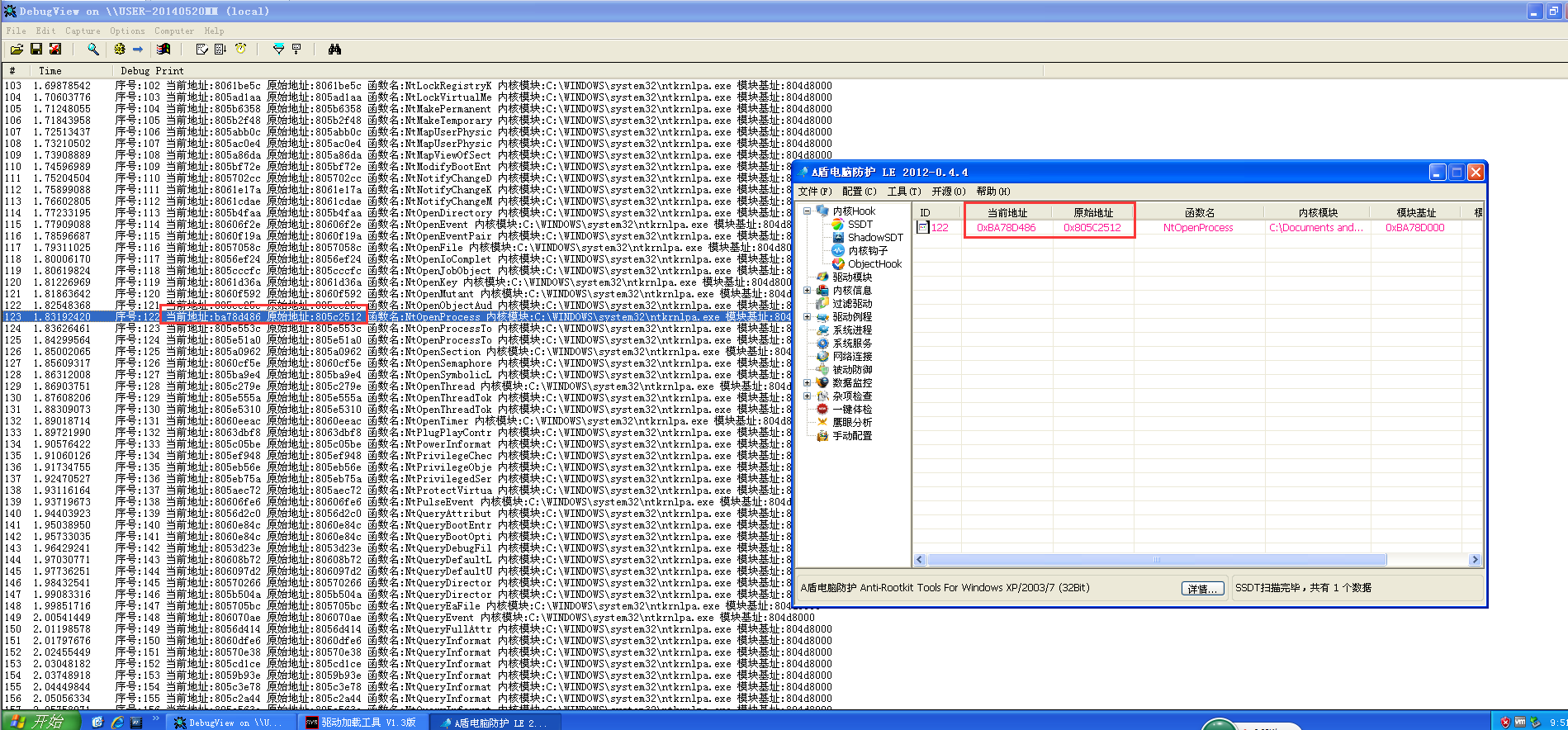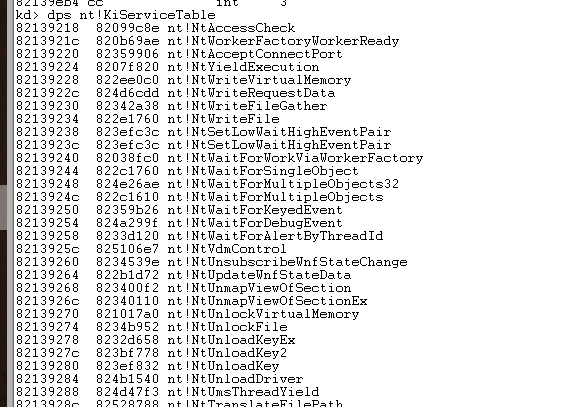获取信息包括函数序号,当前地址,原始地址,函数名,内核模块完整路径,内核模块基址。支持WinAll x86。
#include "ntddk.h"
#include <WinDef.h>
#include "ntimage.h"
int NtosVersion; //判断操作系统内核标志
wchar_t NtosVersionName[4][128]={L"\\??\\C:\\WINDOWS\\system32\\ntoskrnl.exe",L"\\??\\C:\\WINDOWS\\system32\\ntkrnlpa.exe",L"\\??\\C:\\WINDOWS\\system32\\ntkrnlmp.exe",L"\\??\\C:\\WINDOWS\\system32\\ntkrpamp.exe"};
char NtosVersionNameA[4][128]={"C:\\WINDOWS\\system32\\ntoskrnl.exe","C:\\WINDOWS\\system32\\ntkrnlpa.exe","C:\\WINDOWS\\system32\\ntkrnlmp.exe","C:\\WINDOWS\\system32\\ntkrpamp.exe"};
ULONG SSDTNumber=0;
KIRQL Irql;
BOOLEAN IsGetSSDT=false;
typedef struct _SSDTInformation
{
ULONG index;
ULONG CurrentAddress;
ULONG OriginalAddress;
char FunctionName[16]; //函数名
char KernelMouduleName[64]; //内核模块名
ULONG KernelMouduleBase; //内核模块基址
}SSDTInformation,*PSSDTInformation;
PSSDTInformation SSDT;
//SSDT= (PSSDTInformation)ExAllocatePool(NonPagedPool,sizeof(SSDTInformation)*512);
#pragma pack(1)
typedef struct ServiceDescriptorEntry {
unsigned int *ServiceTableBase;
unsigned int *ServiceCounterTableBase;
unsigned int NumberOfServices;
unsigned char *ParamTableBase;
} ServiceDescriptorTableEntry_t, *PServiceDescriptorTableEntry_t;
#pragma pack()
extern"C" __declspec(dllimport) ServiceDescriptorTableEntry_t KeServiceDescriptorTable;
ServiceDescriptorTableEntry_t *pNewSSDT;
ULONG OldImageBase=0; //当前内核在内存中的地址
ULONG ImageBase=0; //文件中的基址
//恢复内存保护
void PageProtectOn()
{
__asm{
mov eax,cr0
or eax,10000h
mov cr0,eax
sti
}
}
//去掉内存保护
void PageProtectOff()
{
__asm{
cli
mov eax,cr0
and eax,not 10000h
mov cr0,eax
}
}
typedef enum _SYSTEM_INFORMATION_CLASS
{
SystemModuleInformation = 11,
} SYSTEM_INFORMATION_CLASS;
typedef struct _SYSTEM_MODULE_INFORMATION
{
ULONG Reserved[2];
PBYTE Base;
ULONG Size;
ULONG Flags;
USHORT Index;
USHORT Unknown;
USHORT LoadCount;
USHORT ModuleNameOffset;
CHAR ImageName[256];
} SYSTEM_MODULE_INFORMATION, *PSYSTEM_MODULE_INFORMATION;
typedef struct _SYSTEM_MODULE_INFO_LIST
{
ULONG ulCount;
SYSTEM_MODULE_INFORMATION smi[1];
} SYSTEM_MODULE_INFO_LIST, *PSYSTEM_MODULE_INFO_LIST;
typedef struct _MY_IMAGE_BASE_RELOCATION {
ULONG VirtualAddress;
ULONG SizeOfBlock;
USHORT TypeOffset[1];
} MY_IMAGE_BASE_RELOCATION;
extern"C" NTSTATUS __stdcall ZwQuerySystemInformation(
SYSTEM_INFORMATION_CLASS SystemInformationClass,
PVOID SystemInformation,
ULONG SystemInformationLength,
PULONG ReturnLength
);
VOID SetNewSSDT(PVOID pNewImage)
{
ULONG uIndex;
ULONG uNewKernelInc,uOffset;
//新内核地址-老内核地址,得到相对偏移
uNewKernelInc = (ULONG)pNewImage -OldImageBase;
//老内核的ssdt指针加上相对偏移,得到新内核的ssdt指针
pNewSSDT = (ServiceDescriptorTableEntry_t *)((ULONG)&KeServiceDescriptorTable + uNewKernelInc);
if (!MmIsAddressValid(pNewSSDT))
{
KdPrint(("pNewSSDT is unaviable!"));
return;
}
//由于数量是一个数值,因此不必作相对偏移
pNewSSDT->NumberOfServices = KeServiceDescriptorTable.NumberOfServices;
//计算相对函数地址
uOffset = (ULONG)KeServiceDescriptorTable.ServiceTableBase -OldImageBase;
//得到新的ssdt函数表地址
pNewSSDT->ServiceTableBase = (unsigned int*)((ULONG)pNewImage + uOffset);
if (!MmIsAddressValid(pNewSSDT->ServiceTableBase))
{
KdPrint(("pNewSSDT->ServiceTableBase: %X",pNewSSDT->ServiceTableBase));
return;
}
//依次遍历
for (uIndex = 0;uIndex<pNewSSDT->NumberOfServices;uIndex++)
{ //新的函数地址再加上相对加载地址,得到现在的ssdt函数地址
pNewSSDT->ServiceTableBase[uIndex] = pNewSSDT->ServiceTableBase[uIndex]-ImageBase+OldImageBase;
//DbgPrint("%d->%08x\n",uIndex,pNewSSDT->ServiceTableBase[uIndex]); //打印SSDT索引号和地址
}
//
//保存SSDT信息
//
SSDT= (PSSDTInformation)ExAllocatePool(NonPagedPool,sizeof(SSDTInformation)*pNewSSDT->NumberOfServices);
if(SSDT==NULL)
{
DbgPrint("申请内存失败\n");
return;
}
else
{
IsGetSSDT=true;
}
for (uIndex = 0;uIndex<pNewSSDT->NumberOfServices;uIndex++)
{
SSDT[uIndex].index = uIndex; //序号
SSDT[uIndex].OriginalAddress=pNewSSDT->ServiceTableBase[uIndex]; //原始地址
SSDT[uIndex].CurrentAddress=KeServiceDescriptorTable.ServiceTableBase[uIndex];
}
SSDTNumber=pNewSSDT->NumberOfServices; //有多少项
}
BOOLEAN LoadKernel()
{
NTSTATUS status;
UNICODE_STRING uFileName;
HANDLE hFile;
OBJECT_ATTRIBUTES ObjAttr;
IO_STATUS_BLOCK IoStatusBlock;
LARGE_INTEGER FileOffset;
ULONG retsize;
PVOID lpVirtualPointer;
ULONG uLoop;
ULONG SectionVirtualAddress,SectionSize;
PIMAGE_DOS_HEADER ImageDosHeader;
PIMAGE_NT_HEADERS ImageNtHeader;
PIMAGE_SECTION_HEADER lpImageSectionHeader;
InitializeObjectAttributes(&ObjAttr,\
&uFileName,\
OBJ_CASE_INSENSITIVE,\
NULL,\
NULL);
RtlInitUnicodeString(&uFileName,NtosVersionName[NtosVersion]);
//打开文件
status = ZwCreateFile(\
&hFile,\
FILE_ALL_ACCESS,\
&ObjAttr,\
&IoStatusBlock,\
0,\
FILE_ATTRIBUTE_NORMAL,\
FILE_SHARE_READ,\
FILE_OPEN,\
FILE_NON_DIRECTORY_FILE,\
NULL,\
0);
if(!NT_SUCCESS(status))
{
KdPrint(("CreateFile Failed!\n"));
return false;
}
//读取DOS头
FileOffset.QuadPart = 0;
ImageDosHeader=(PIMAGE_DOS_HEADER)ExAllocatePool(NonPagedPool, sizeof(IMAGE_DOS_HEADER)); //记得释放
status = ZwReadFile(hFile,\
NULL,\
NULL,\
NULL,\
&IoStatusBlock,\
ImageDosHeader,\
sizeof(IMAGE_DOS_HEADER),\
&FileOffset,\
0);
if(!NT_SUCCESS(status))
{
KdPrint(("Read ImageDosHeader Failed!"));
ZwClose(hFile);
return false;
}
//读取NT头
ImageNtHeader=(PIMAGE_NT_HEADERS)ExAllocatePool(NonPagedPool, sizeof(IMAGE_NT_HEADERS)); //记得释放
FileOffset.QuadPart = ImageDosHeader->e_lfanew;
status = ZwReadFile(hFile,\
NULL,\
NULL,\
NULL,\
&IoStatusBlock,\
ImageNtHeader,\
sizeof(IMAGE_NT_HEADERS),\
&FileOffset,\
0);
if(!NT_SUCCESS(status))
{
KdPrint(("Read ImageNtHeaders Failed!"));
ZwClose(hFile);
return false;
}
ImageBase=ImageNtHeader->OptionalHeader.ImageBase;
//读取区表
lpImageSectionHeader = (PIMAGE_SECTION_HEADER)ExAllocatePool(NonPagedPool,sizeof(IMAGE_SECTION_HEADER)*ImageNtHeader->FileHeader.NumberOfSections);
FileOffset.QuadPart += sizeof(IMAGE_NT_HEADERS);
status = ZwReadFile(hFile,\
NULL,\
NULL,\
NULL,\
&IoStatusBlock,\
lpImageSectionHeader,\
sizeof(IMAGE_SECTION_HEADER)*ImageNtHeader->FileHeader.NumberOfSections,\
&FileOffset,\
0);
if(!NT_SUCCESS(status))
{
KdPrint(("Read ImageSectionHeader Failed!"));
ExFreePool(lpImageSectionHeader);
ZwClose(hFile);
return false;
}
//COPY数据到内存
lpVirtualPointer = ExAllocatePool(NonPagedPool,\
ImageNtHeader->OptionalHeader.SizeOfImage);
if(lpVirtualPointer == 0)
{
KdPrint(("lpVirtualPointer Alloc space Failed!"));
ZwClose(hFile);
return false;
}
memset(lpVirtualPointer,0,ImageNtHeader->OptionalHeader.SizeOfImage);
//COPY DOS头
RtlCopyMemory(lpVirtualPointer,\
ImageDosHeader,\
sizeof(IMAGE_DOS_HEADER));
//COPY NT头
RtlCopyMemory((PVOID)((ULONG)lpVirtualPointer+ImageDosHeader->e_lfanew),\
ImageNtHeader,\
sizeof(IMAGE_NT_HEADERS));
//COPY 区表
RtlCopyMemory((PVOID)((ULONG)lpVirtualPointer+ImageDosHeader->e_lfanew+sizeof(IMAGE_NT_HEADERS)),\
lpImageSectionHeader,\
sizeof(IMAGE_SECTION_HEADER)*ImageNtHeader->FileHeader.NumberOfSections);
//依次COPY 各区段数据
for(uLoop = 0;uLoop < ImageNtHeader->FileHeader.NumberOfSections;uLoop++)
{
SectionVirtualAddress = lpImageSectionHeader[uLoop].VirtualAddress;//对应区段相对偏移
if(lpImageSectionHeader[uLoop].Misc.VirtualSize > lpImageSectionHeader[uLoop].SizeOfRawData)
SectionSize = lpImageSectionHeader[uLoop].Misc.VirtualSize;//取最大的占用空间
else
SectionSize = lpImageSectionHeader[uLoop].SizeOfRawData;
FileOffset.QuadPart = lpImageSectionHeader[uLoop].PointerToRawData;//对应区段的超始地址
status = ZwReadFile(hFile,\
NULL,\
NULL,\
NULL,\
&IoStatusBlock,\
(PVOID)((ULONG)lpVirtualPointer+SectionVirtualAddress),\
SectionSize,\
&FileOffset,\
0);
if(!NT_SUCCESS(status))
{
KdPrint(("SectionData Read Failed!"));
ExFreePool(lpImageSectionHeader);
ExFreePool(lpVirtualPointer);
ZwClose(hFile);
return false;
}
}
SetNewSSDT(lpVirtualPointer);
ExFreePool(lpImageSectionHeader);//释放区段内存空间
ExFreePool(ImageNtHeader);
ZwClose(hFile);//关闭句柄
return true;
}
// 获取kernel模块的信息
NTSTATUS GetKernelModuleInfo()
{
NTSTATUS status = STATUS_UNSUCCESSFUL;
PSYSTEM_MODULE_INFO_LIST pSysModInfoList = NULL;
ULONG ulLength = 0;
status = ZwQuerySystemInformation(SystemModuleInformation, pSysModInfoList, ulLength, &ulLength);
if(status != STATUS_INFO_LENGTH_MISMATCH)
{
return STATUS_UNSUCCESSFUL;
}
pSysModInfoList = (PSYSTEM_MODULE_INFO_LIST)ExAllocatePool(NonPagedPool, ulLength);
if(NULL == pSysModInfoList)
{
return STATUS_UNSUCCESSFUL;
}
status = ZwQuerySystemInformation(SystemModuleInformation, pSysModInfoList, ulLength, &ulLength);
if(!NT_SUCCESS(status))
{
ExFreePool(pSysModInfoList);
return STATUS_UNSUCCESSFUL;
}
OldImageBase=(ULONG)pSysModInfoList->smi[0].Base; //得到当前内核的基址
if(strstr(pSysModInfoList->smi[0].ImageName,"ntoskrnl.exe"))
{
NtosVersion=0;
}
if(strstr(pSysModInfoList->smi[0].ImageName,"ntkrnlpa.exe"))
{
NtosVersion=1;
}
if(strstr(pSysModInfoList->smi[0].ImageName,"ntkrnlmp.exe"))
{
NtosVersion=2;
}
if(strstr(pSysModInfoList->smi[0].ImageName,"ntkrpamp.exe"))
{
NtosVersion=3;
}
ExFreePool(pSysModInfoList);
return STATUS_SUCCESS;
}
NTSTATUS Status;
HANDLE FileHandle;
IO_STATUS_BLOCK ioStatus;
FILE_STANDARD_INFORMATION FileInformation;
BOOLEAN GetSSDTName()
{
if (KeGetCurrentIrql() > PASSIVE_LEVEL)
{
return STATUS_UNSUCCESSFUL;
}
//设置NTDLL路径
UNICODE_STRING uniFileName;
RtlInitUnicodeString(&uniFileName, L"\\SystemRoot\\system32\\ntdll.dll");
//初始化打开文件的属性
OBJECT_ATTRIBUTES objectAttributes;
InitializeObjectAttributes(&objectAttributes, &uniFileName,
OBJ_KERNEL_HANDLE | OBJ_CASE_INSENSITIVE, NULL, NULL);
////创建文件
Status = IoCreateFile(&FileHandle, FILE_READ_ATTRIBUTES | SYNCHRONIZE, &objectAttributes,
&ioStatus, 0, FILE_READ_ATTRIBUTES, FILE_SHARE_READ, FILE_OPEN, FILE_SYNCHRONOUS_IO_NONALERT,
NULL, 0, CreateFileTypeNone, NULL, IO_NO_PARAMETER_CHECKING);
if (!NT_SUCCESS(Status))
{
DbgPrint("IoCreateFile failed!status:0x%08x\n", Status);
return false;
}
//获取文件信息
Status = ZwQueryInformationFile(FileHandle, &ioStatus, &FileInformation,
sizeof(FILE_STANDARD_INFORMATION), FileStandardInformation);
if (!NT_SUCCESS(Status))
{
DbgPrint("ZwQueryInformationFile failed!status:0x%08x\n", Status);
ZwClose( FileHandle );
return false;
}
//判断文件大小是否过大
if (FileInformation.EndOfFile.HighPart != 0)
{
DbgPrint("File Size Too High");
ZwClose(FileHandle);
return false;
}
//取文件大小
ULONG uFileSize = FileInformation.EndOfFile.LowPart;
//分配内存
PVOID pBuffer = ExAllocatePoolWithTag(PagedPool, uFileSize, (ULONG)"NTDLL");
if (pBuffer == NULL)
{
DbgPrint("ExAllocatePoolWithTag() == NULL");
ZwClose(FileHandle);
return false;
}
//从头开始读取文件
LARGE_INTEGER byteOffset;
byteOffset.LowPart = 0;
byteOffset.HighPart = 0;
Status = ZwReadFile(FileHandle, NULL, NULL, NULL, &ioStatus, pBuffer, uFileSize, &byteOffset, NULL);
if (!NT_SUCCESS(Status))
{
DbgPrint("ZwReadFile failed!status:0x%08x\n", Status);
ZwClose(FileHandle);
return false;
}
//取出导出表
PIMAGE_DOS_HEADER pDosHeader;
PIMAGE_NT_HEADERS pNtHeaders;
PIMAGE_SECTION_HEADER pSectionHeader;
ULONG FileOffset;
PIMAGE_EXPORT_DIRECTORY pExportDirectory;
//DLL内存数据转成DOS头结构
pDosHeader = (PIMAGE_DOS_HEADER)pBuffer;
//取出PE头结构
pNtHeaders = (PIMAGE_NT_HEADERS)((ULONG)pBuffer + pDosHeader->e_lfanew);
//判断PE头导出表表是否为空
if (pNtHeaders->OptionalHeader.DataDirectory[IMAGE_DIRECTORY_ENTRY_EXPORT].VirtualAddress == 0)
{
DbgPrint("VirtualAddress == 0");
return false;
}
//取出导出表偏移
FileOffset = pNtHeaders->OptionalHeader.DataDirectory[IMAGE_DIRECTORY_ENTRY_EXPORT].VirtualAddress;
//取出节头结构
pSectionHeader = (PIMAGE_SECTION_HEADER)((DWORD)pNtHeaders + sizeof(IMAGE_NT_HEADERS));
PIMAGE_SECTION_HEADER pOldSectionHeader = pSectionHeader;
//遍历节结构进行地址运算
for (WORD Index = 0; Index < pNtHeaders->FileHeader.NumberOfSections; Index++, pSectionHeader++)
{
if (pSectionHeader->VirtualAddress <= FileOffset &&
FileOffset <= pSectionHeader->VirtualAddress + pSectionHeader->SizeOfRawData)
{
FileOffset = FileOffset - pSectionHeader->VirtualAddress + pSectionHeader->PointerToRawData;
}
}
//导出表地址
pExportDirectory = (PIMAGE_EXPORT_DIRECTORY)((ULONG)pBuffer + FileOffset);
//取出导出表函数地址
PULONG AddressOfFunctions;
FileOffset = pExportDirectory->AddressOfFunctions;
//遍历节结构进行地址运算
pSectionHeader = pOldSectionHeader;
for (WORD Index = 0; Index < pNtHeaders->FileHeader.NumberOfSections; Index++, pSectionHeader++)
{
if (pSectionHeader->VirtualAddress <= FileOffset &&
FileOffset <= pSectionHeader->VirtualAddress + pSectionHeader->SizeOfRawData)
{
FileOffset = FileOffset - pSectionHeader->VirtualAddress + pSectionHeader->PointerToRawData;
}
}
AddressOfFunctions = (PULONG)((ULONG)pBuffer + FileOffset);
//取出导出表函数名字
PUSHORT AddressOfNameOrdinals;
FileOffset = pExportDirectory->AddressOfNameOrdinals;
//遍历节结构进行地址运算
pSectionHeader = pOldSectionHeader;
for (WORD Index = 0; Index < pNtHeaders->FileHeader.NumberOfSections; Index++, pSectionHeader++)
{
if (pSectionHeader->VirtualAddress <= FileOffset &&
FileOffset <= pSectionHeader->VirtualAddress + pSectionHeader->SizeOfRawData)
{
FileOffset = FileOffset - pSectionHeader->VirtualAddress + pSectionHeader->PointerToRawData;
}
}
AddressOfNameOrdinals = (PUSHORT)((ULONG)pBuffer + FileOffset);
//取出导出表函数序号
PULONG AddressOfNames;
FileOffset = pExportDirectory->AddressOfNames;
//遍历节结构进行地址运算
pSectionHeader = pOldSectionHeader;
for (WORD Index = 0; Index < pNtHeaders->FileHeader.NumberOfSections; Index++, pSectionHeader++)
{
if (pSectionHeader->VirtualAddress <= FileOffset &&
FileOffset <= pSectionHeader->VirtualAddress + pSectionHeader->SizeOfRawData)
{
FileOffset = FileOffset - pSectionHeader->VirtualAddress + pSectionHeader->PointerToRawData;
}
}
AddressOfNames = (PULONG)((ULONG)pBuffer + FileOffset);
//分析导出表
ULONG uNameOffset;
ULONG uOffset;
LPSTR FunName;
PVOID pFuncAddr;
ULONG uServerIndex;
ULONG uAddressOfNames;
for (ULONG uIndex = 0; uIndex < pExportDirectory->NumberOfNames; uIndex++, AddressOfNames++, AddressOfNameOrdinals++)
{
uAddressOfNames = *AddressOfNames;
pSectionHeader = pOldSectionHeader;
for (WORD Index = 0; Index < pNtHeaders->FileHeader.NumberOfSections; Index++, pSectionHeader++)
{
if (pSectionHeader->VirtualAddress <= uAddressOfNames &&
uAddressOfNames <= pSectionHeader->VirtualAddress + pSectionHeader->SizeOfRawData)
{
uOffset = uAddressOfNames - pSectionHeader->VirtualAddress + pSectionHeader->PointerToRawData;
}
}
FunName = (LPSTR)((ULONG)pBuffer + uOffset);
if (FunName[0] == 'Z' && FunName[1] == 'w')
{
pSectionHeader = pOldSectionHeader;
uOffset = (ULONG)AddressOfFunctions[*AddressOfNameOrdinals];
for (WORD Index = 0; Index < pNtHeaders->FileHeader.NumberOfSections; Index++, pSectionHeader++)
{
if (pSectionHeader->VirtualAddress <= uOffset&&
uOffset <= pSectionHeader->VirtualAddress + pSectionHeader->SizeOfRawData)
{
uNameOffset = uOffset - pSectionHeader->VirtualAddress + pSectionHeader->PointerToRawData;
}
}
pFuncAddr = (PVOID)((ULONG)pBuffer + uNameOffset);
uServerIndex = *(PULONG)((ULONG)pFuncAddr + 1);
FunName[0] = 'N';
FunName[1] = 't';
//KdPrint(("序列号为:%d,函数名为: %s\n", uServerIndex, FunName));
RtlCopyMemory(SSDT[uServerIndex].FunctionName,FunName,sizeof(char)*15); //保存函数名
SSDT[uServerIndex].KernelMouduleBase=OldImageBase; //保存内核模块基址
RtlCopyMemory(SSDT[uServerIndex].KernelMouduleName,NtosVersionNameA[NtosVersion],sizeof(char)*63); //保存内核模块名
}
}
ExFreePoolWithTag(pBuffer , (ULONG)"NTDLL");
ZwClose(FileHandle);
return true;
}
void DriverUnload(PDRIVER_OBJECT pDriverObject)
{
if(IsGetSSDT)
{
ExFreePool(SSDT);
}
DbgPrint("Driver Unload...\n");
}
NTSTATUS DriverEntry(PDRIVER_OBJECT pDriverObject,PUNICODE_STRING pRegsiterPath)
{
int i=0;
pDriverObject->DriverUnload = DriverUnload;
if(NT_SUCCESS(GetKernelModuleInfo())) //获取当前内核信息
{
if(LoadKernel()) //加载内核
{
if(GetSSDTName())
{
for(int i=0;i<SSDTNumber;i++)
{
DbgPrint("序号:%d 当前地址:%08x 原始地址:%08x 函数名:%s 内核模块:%s 模块基址:%08x\n",SSDT[i].index,SSDT[i].CurrentAddress,SSDT[i].OriginalAddress,SSDT[i].FunctionName,SSDT[i].KernelMouduleName,SSDT[i].KernelMouduleBase);
}
}
else
{
DbgPrint("GetSSDTName failed!\n");
}
}
else
{
DbgPrint("LoadKernel failed!\n");
}
}
else
{
DbgPrint("GetKernelModuleInfo failed!\n");
}
DbgPrint("Driver Onload...\n");
return STATUS_SUCCESS;
}
大量参考了论坛其他人的代码,
无图无真相,上!
XP:


 Windows 10
Windows 10




Windows10比较坑,内核文件会被进程占用,如果你直接打开会失败。关于这个我在http://www.netfairy.net/?post=232 第五点提到。解决的办法之一:CopyFileEx把内核文件复制到临时目录,用完再删除。最近写内核代码蓝屏多多,惊喜多多!

[招生]科锐逆向工程师培训(2024年11月15日实地,远程教学同时开班, 第51期)